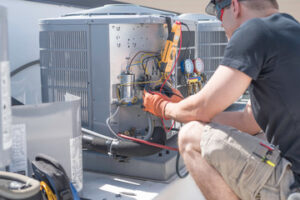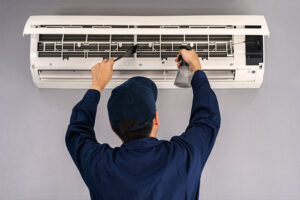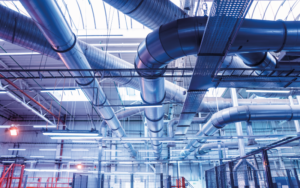A malfunctioning AC system can end up costing you a lot of money. Fortunately, most problems are actually minor and easy to fix. However, if they are not addressed quickly, they can become much bigger issues that may force you to replace your unit.
Having regular maintenance done minimizes the number of repairs your HVAC system needs to make throughout the year. This includes identifying and repairing leaks, cleaning and replacing air filters, and ensuring proper airflow. Contact AC Repair Tempe now!

When your AC isn’t working properly, it can cost a lot to hire a professional. However, there are several things to consider before making a decision. First, you should find a reputable company. This can be done by searching for local companies on Google or looking at their websites. You should also check out customer reviews and ask for estimates.
The type of AC you have and the problem that needs to be fixed will impact the overall repair costs. For example, window cooling units are typically less expensive to repair than central air conditioning systems. It is also more common for problems with central AC systems to occur in the summer when the unit is being used the most.
Other factors that impact AC repair costs include the age of the unit and its brand. Older units are more likely to experience frequent repairs and may be better off being replaced. This is especially true for units that have been poorly maintained and are nearing the end of their lifespans.
Another important factor is the accessibility of the unit’s components. If any of the parts are located in hard-to-reach places like your roof or a narrow crawl space, it can greatly increase your repair costs. Finally, the time of year you choose to have your AC repaired will affect the repair costs as well. During the summer, AC techs will be busy and may charge higher hourly rates to ensure they have enough time to complete all of their repairs.
If your AC system’s blower motor isn’t pushing cool air into the ductwork, it may cost as little as $150 to fix. However, if the blower motor is beyond repair, it can cost as much as $800 or more.
Keeping up with regular maintenance on HVAC systems helps ensure safety, extend the system’s lifespan, optimize performance and efficiency, reduce energy costs, and maintain indoor air quality. However, if an AC unit isn’t easily accessible, it can be difficult for technicians to diagnose and repair problems. This can lead to costly AC repairs and insufficient cooling.
In many cases, there are things you can do to troubleshoot and even fix an AC problem before calling in a professional. For example, if your air conditioner isn’t cooling and you notice lukewarm air coming out of your vents, check your thermostat settings. If they are incorrect, reset them.
Another common AC issue is a broken fan or motor. It may be caused by clogged or dirty air filters, which can lead to overworking the motor and shortening its lifespan. Lastly, make sure the vents and registers in each room are open and not blocked by furniture. These blocks can restrict airflow and prevent the HVAC system from cooling the entire home or office.
Other issues can include a faulty capacitor or refrigerant leaks, which can be very dangerous and require the assistance of an experienced technician. Additionally, if the AC unit isn’t draining properly, a clogged or damaged air filter could be the culprit.
The most important reason to prioritize AC repairs is for safety. Faulty electrical connections, worn-out wires, and leaking refrigerant all pose fire hazards. Delaying AC repairs increases the risk of such disasters and can result in significant property damage. Additionally, a malfunctioning AC system can leak refrigerant into the living or working space, creating an environment that’s unsuitable for work or rest.
As your air conditioning system ages, the components begin to wear out and you may need to repair or replace them. This will depend on the quality of your unit and how well it has been maintained, as well as its expected lifespan.
It is important to promptly address AC repairs, as failing to do so can lead to serious consequences. A malfunctioning AC can cause uncomfortable temperatures in your living or working space, which negatively impacts productivity and sleep patterns. In addition, it can create unhealthy indoor air that aggravates allergies and other respiratory conditions.
If you notice your energy bill rising or hear humming sounds coming from your air conditioner, it is probably time for repairs. The humming sound could be caused by an issue with your condenser’s capacitor, which is responsible for powering the system. A capacitor that is worn out will not provide the necessary amount of electricity to your air conditioner, causing it to malfunction. If you delay repairing this problem, your air conditioner’s efficiency will decline and you’ll see an increase in your energy bills.
If your air conditioning unit is older than 15 years, it’s likely time to consider replacing it. An older AC is less efficient and requires more frequent repairs. A new air conditioner will reduce your energy costs and improve comfort throughout the home. It’s also a good idea to look for replacement AC units with advanced features, such as humidity control and energy-efficient operation. These features will help you save money over the long term.
When your air conditioning system is in need of repair, the right company can help you get it up and running again. Some companies offer emergency repairs, while others have a variety of other services that can address various issues. Some common problems include ice or dirt buildup, low refrigerant, and broken coils. Some also have a maintenance program that can prevent many problems and improve the lifespan of your unit.
The thermostat and control center are the brains of your AC, telling the condenser to run. If these are damaged, they cannot provide the necessary power to the compressor, and the cooling process will not begin. Additionally, the capacitor may be damaged or out of commission.
In addition to reducing indoor air quality, malfunctioning AC systems can pose a safety hazard. Faulty wires and electrical connections are a fire risk, while leaky refrigerants present inhalation hazards. Prioritizing timely repairs can reduce these risks, ensuring the health and safety of your home or business. If you are in need of a repair, you should contact a local company that specializes in installing and operating packaged terminal air conditioners (PTAC). This is a family-owned and operated company that serves residential and commercial clients throughout.
A warranty is an important part of any AC repair. It protects against costly repairs and allows you to replace your equipment if it is not working properly. However, it is essential to understand the conditions and limitations of a warranty before purchasing one. Typically, warranties cover replacement parts but not labor charges. You should also check for other exclusions or restrictions. Some warranties require that you work with a certified service provider to receive coverage. Others require that you register your HVAC system within a specified timeframe to activate the warranty.
If you are considering purchasing a home warranty to help offset the cost of repairing your HVAC, you should read the terms and conditions carefully. Many of these warranties have stipulations that prohibit certain circumstances from being covered, such as damage caused by natural disasters or by a so-called act of god. It is also important to know that most home warranty companies only work with a limited number of contractors, so you may not have much choice in choosing the service provider who will come to your home.
Another common exclusion in home warranties is the failure to perform regular maintenance. It is important to keep in mind that these policies are designed to pay for wear-related damage, but they assume that homeowners take steps to limit this damage. If you do not perform routine maintenance, your warranty may be voided and you will have to pay for any repairs or replacements that you need. Therefore, it is a good idea to save receipts and maintenance documentation for your appliances or systems in a safe place. You can also ask for this documentation from the sellers of a home you are interested in buying or to hang on to it yourself after your purchase.



